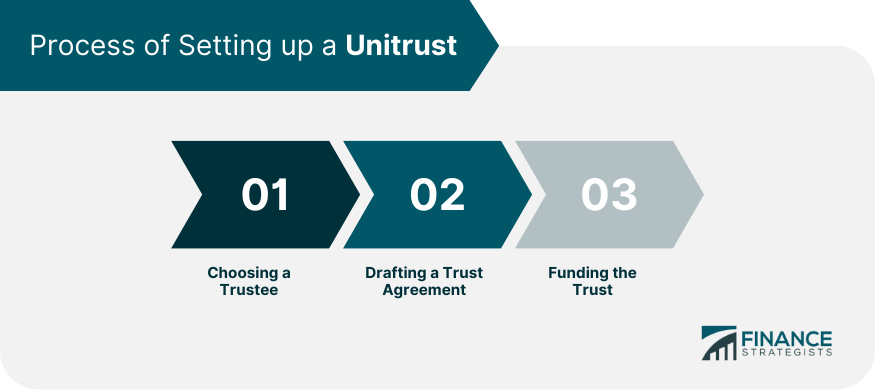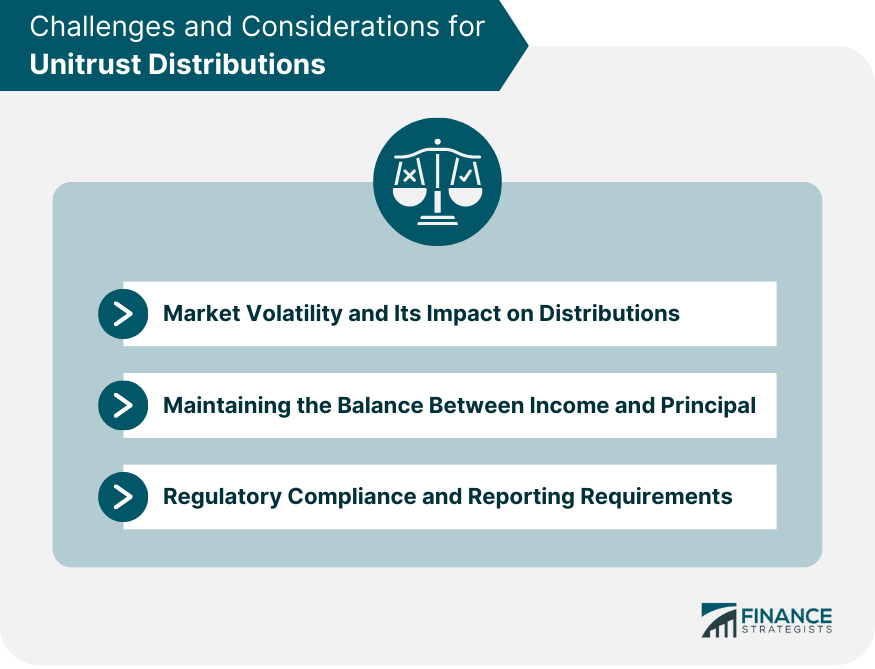Unitrust distributions play an essential role in estate and charitable planning, offering tax benefits and a reliable income stream for beneficiaries. A unitrust, or charitable remainder unitrust (CRUT), is a type of irrevocable trust that provides an annual income stream to its beneficiaries, based on a percentage of the trust's assets. Upon termination of the trust, the remaining assets are distributed to one or more designated charitable organizations. Unitrust distributions serve a dual purpose: providing income for beneficiaries and supporting charitable organizations. The trust allows for potential growth of assets, resulting in increased income over time. Tax benefits include income, capital gains, and estate tax deductions. There are four main types of unitrusts, each with its unique features and distribution methods: Setting up a unitrust requires careful planning and adherence to specific eligibility requirements. To establish a unitrust, the trust must meet the requirements set forth by the Internal Revenue Service (IRS). These include a minimum payout rate, a qualified charitable remainder beneficiary, and proper trust documentation. The process involves three main steps: Unitrusts offer various tax benefits: Charitable deductions: Donors may claim an income tax deduction for the present value of the remainder interest that will eventually go to the charitable beneficiary. Capital gains tax: Assets transferred to the trust can be sold without incurring immediate capital gains tax. Estate tax: The trust assets are removed from the donor's estate, reducing potential estate taxes. Several factors determine the amount of unitrust distributions: The distribution rate is a percentage of the trust's assets paid out annually. Factors affecting the rate include the trust's purpose, beneficiaries' needs, and the donor's tax objectives. The IRS sets minimum and maximum allowable rates. Trust assets must be valued annually, using either the fair market value or an alternative valuation method approved by the IRS. Distributions can be made annually, semi-annually, or quarterly. Payment deadlines are typically set by the trust agreement. Unitrust distributions can consist of income and principal from the trust's assets. Income generated by the trust can include interest, dividends, rents, and capital gains. Distributions are usually made in the form of a pro-rata share of income and principal. Ordering rules determine which types of income are distributed first. Unitrusts can have both individual and charitable beneficiaries. Non-charitable beneficiaries receive income from the trust, while charitable beneficiaries receive the remaining assets upon trust termination. The interest of a beneficiary in a unitrust can be for a specific term of years or for the lifetime of the beneficiary. Beneficiaries have different interests in a unitrust: Income interest: The right to receive income distributions from the trust during the term or their lifetime. Remainder interest: The right to receive the remaining trust assets upon termination of the trust. Unitrusts can be terminated under specific conditions. Common conditions for terminating a unitrust include the expiration of the trust term, the death of the beneficiary, or at the trustee's discretion. Upon termination, the remaining assets are distributed to the designated beneficiaries: Non-charitable beneficiaries: May receive any remaining income interest or principal, depending on the trust agreement. Charitable remainder beneficiaries: Receive the remaining trust assets as a charitable gift. The termination of a unitrust may have tax implications, including potential capital gains or income tax liabilities for beneficiaries. Several challenges and considerations are associated with unitrust distributions. Market fluctuations can affect the value of trust assets and, consequently, the amount of distributions. Trustees must manage assets to provide a consistent income stream for beneficiaries while preserving the principal for the charitable remainder beneficiary. Trustees must ensure compliance with all regulatory and reporting requirements, including filing annual tax returns and providing necessary documentation to beneficiaries. Unitrust distributions serve as an essential tool in estate and charitable planning, offering both income for beneficiaries and support for charitable organizations. The process of establishing a unitrust involves meeting eligibility requirements, drafting a trust agreement, and funding the trust. Tax benefits, such as charitable deductions, capital gains tax advantages, and estate tax reduction, make unitrusts an attractive option for donors. Understanding the factors that determine unitrust distributions, such as distribution rates, valuation of trust assets, and payout frequency, is crucial for effective trust management. Beneficiaries, both individual and charitable, have distinct interests in a unitrust, which can last for a term of years or the beneficiary's lifetime. The termination of a unitrust involves distributing the remaining assets to the designated beneficiaries and may have tax implications. As unitrusts require balancing income and principal while navigating market volatility and regulatory compliance, it is essential to consult with financial and legal professionals for guidance. By carefully considering the various aspects of unitrusts, donors can establish and maintain a trust that meets their individual needs and objectives while supporting their chosen charitable causes.Unitrust Distributions: Overview
1. Standard Unitrust
2. Net Income Unitrust
3. Net Income With Makeup Unitrust
4. Flip Unitrust
Establishing a Unitrust
Eligibility Requirements
Process of Setting up a Unitrust
1. Choosing a trustee: A trustee is responsible for managing the trust assets and making distributions. This can be an individual, a financial institution, or a combination of both.
2. Drafting a trust agreement: A trust agreement is a legal document outlining the terms of the trust, including the distribution rate, beneficiaries, and termination provisions.
3. Funding the trust: Trust assets can include cash, securities, real estate, or other property.

Tax Implications and Benefits
Calculating Unitrust Distributions
Distribution Rate
Valuation of Trust Assets
Payout Frequency and Timing
Income and Principal Distributions
Types of Income
Distribution of Income and Principal
Beneficiaries of Unitrust Distributions
Individual Beneficiaries
Duration of Beneficiary Interest
Rights and Responsibilities of Beneficiaries
Termination of a Unitrust
Conditions for Termination
Distribution of Remaining Assets
Tax Implications of Termination
Challenges and Considerations
Market Volatility and Its Impact on Distributions
Maintaining the Balance Between Income and Principal
Regulatory Compliance and Reporting Requirements

Conclusion
Unitrust Distributions FAQs
Unitrust Distributions refer to the annual distributions made by a Unitrust to its beneficiaries. These distributions are calculated as a percentage of the trust's assets and are made to the beneficiaries on a regular basis.
A Unitrust is a type of trust that pays a fixed percentage of its assets each year to its beneficiaries, typically over the lifetime of the beneficiaries. The percentage is determined when the trust is established and is typically between 3% and 5% of the trust's assets.
Unitrust Distributions are calculated as a fixed percentage of the trust's assets. The percentage is determined when the trust is established and remains the same each year. For example, if a Unitrust is established with a 4% distribution rate and has assets of $1 million, the annual distribution to the beneficiary would be $40,000.
Unitrust Distributions are typically taxable as ordinary income to the beneficiary. However, if the trust is established as a tax-exempt trust, the distributions may be tax-free. It is recommended that individuals consult with a financial advisor or tax professional to understand the tax implications of Unitrust Distributions.
The distribution rate of a Unitrust cannot be changed once the trust is established. However, it is possible to establish multiple Unitrusts with different distribution rates, or to establish a different type of trust with a different distribution structure. It is recommended that individuals consult with an attorney or financial advisor to understand their options when establishing a trust.
True Tamplin is a published author, public speaker, CEO of UpDigital, and founder of Finance Strategists.
True is a Certified Educator in Personal Finance (CEPF®), author of The Handy Financial Ratios Guide, a member of the Society for Advancing Business Editing and Writing, contributes to his financial education site, Finance Strategists, and has spoken to various financial communities such as the CFA Institute, as well as university students like his Alma mater, Biola University, where he received a bachelor of science in business and data analytics.
To learn more about True, visit his personal website or view his author profiles on Amazon, Nasdaq and Forbes.















